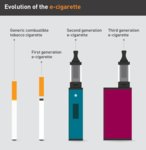

More teenagers than ever have picked up the risky habit of “vaping” or “juuling.” In 2011, less than 2 percent of U.S. high school students reported using e-cigarettes during the previous thirty days. Fast-forward to 2015, and 16 percent had. According to the authors of a recent article published in the New England Journal of Medicine, approximately 1.3 million additional adolescents used some form of e-cigarette in 2018, compared with 2017. These are alarming numbers for parents, public health experts, and doctors like myself.
Teen vaping on the rise
I see many things driving the increase: Robust advertising from e-cigarette companies, the availability of appealing flavors, and peer influence. When teens see other teens vaping it normalizes the behavior, similar to how cigarette smoking was normalized during the last century. It used to be common to see people lighting up everywhere.
We don’t want to reach the point where vaping becomes acceptable. This habit has some immediate impacts and likely carries some serious, long-term dangers we are not even aware of yet.
Lungs feel the effects
Most of the limited research we have on e-cigarettes comes from animal studies. The evidence suggests that, in the short term, e-cigarette vapor causes inflammation in the lungs. The inflammation looks similar to that found in asthma patients’ lungs. This inflammation explains the symptoms we sometimes see in e-cigarette smokers, such as cough and increased phlegm production.
Nicotine addiction is another risk. Adolescents who didn’t use nicotine-containing products in the past, but who use e-cigarettes, have an increased risk of nicotine dependence. This could lead to traditional cigarette use in the future.
Long-term dangers unknown
However, the biggest concern with vaping is the unknown. E-cigarette liquids consist of glycerol, nicotine, and flavoring. There are more than 7,000 different flavors available. Coca-Cola, menthol, and butterscotch are a few examples. Those flavors are usually safe when they are used in food and ingested orally. Little is known about the long-term safety of inhaling those materials. The majority of flavorings have never been analyzed.
The scientific community doesn’t yet know the risks of vaping on our health over time. Burning chemicals and converting them to vapor might change their impact. That’s the scary piece. The simple act of heating chemicals may make them carcinogenic and increase the risk of lung and other cancers. It will take time and effort to identify the long-term impact of e-cigarettes use. While the perception among teenagers is that they are less dangerous than regular cigarettes, there’s not enough research to support that idea.
Educating teens, parents is key
Keeping teens away from vape products can be difficult. They’re readily available online. In Washington, it’s legal to sell them to anyone 18 and over. However, knowledge is power. It’s important for parents and teachers to educate kids about the risks of e-cigarettes. Adults can also support laws that raise the legal purchase age to 21 and restrict vaping and smoking in public places. Parents of teens who have started can encourage their kids to quit. Most of the time, it’s easier to quit vaping than to quit smoking cigarettes. The sooner kids stop the easier it is.
Dr. Bashar Alkinj is a pulmonologist at Vancouver Clinic. He believes that educating patients is a key part of delivering exceptional care.
{{tncms-inline content="<p class="p1">Information from the Food and Drug Administration&rsquo;s 2018 National Youth Tobacco Survey<span class="Apple-converted-space">&nbsp;</span></p> <p class="p2"><span class="s1">&bull; More than 3.6 million middle and high school students were current (past 30 day) e-cigarette users in 2018, an increase of more than 1.5 million students since last year.<span class="Apple-converted-space">&nbsp;</span></span></p> <p class="p2"><span class="s1">&bull; The number of U.S. high school students who reported being current e-cigarette users increased 78 percent between 2017 and 2018 to 3.05 million (or 20.8 percent).<span class="Apple-converted-space">&nbsp;</span></span></p> <p class="p2"><span class="s1">&bull; The number of middle school students rose 48 percent to 570,000 (or 4.9 percent).<span class="Apple-converted-space">&nbsp;</span></span></p> <p class="p2"><span class="s1">&bull; The uptick in e-cigarette use has led overall tobacco product use to increase by 38 percent among high school students (to 27.1 percent) and by 29 percent among middle school students (to 7.2 percent) in the last year, reversing decline seen over the last few years.</span></p> <p class="p2"><span class="s1">&bull; High school students who reported being current e-cigarette users also reported using the product more frequently. In the last year, the proportion of those using the product more regularly (on 20 or more of the past 30 days) increased from 20 percent to 27.7 percent, a one-year rise.<span class="Apple-converted-space">&nbsp;</span></span></p> <p class="p2"><span class="s1">&bull; Among high school e-cigarette users, there is a significant increase in current flavored e-cigarette use within the past year, from 60.9 percent to 67.8 percent.<span class="Apple-converted-space">&nbsp;</span></span></p>" id="d7bc6bed-a869-438d-8162-c929b3350e8c" style-type="bio" title="Just the stats" type="relcontent"}}